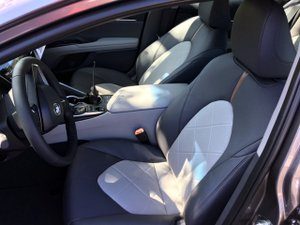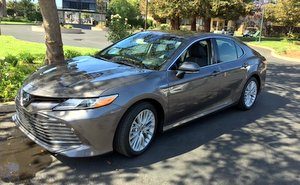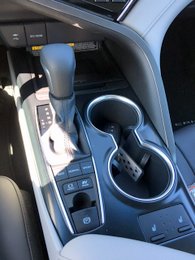First Look at the New Generation
The all-new 8th-generation Camry is the most bold and adventurous version ever of Toyota’s bestselling midsize sedan. When you remember the box this car was when it debuted in 1983, it’s breathtaking what’s happened.
During a brief test drive, I piloted two gasoline-only models along with the 2018 Toyota Camry Hybrid XLE. All wear the same forthright, heavily creased body style. Inside, you’ll find a Lexus-like cabin with the dramatic dashboard swoosh introduced in Toyotas with the latest generation Prius. Although nothing is carried over but the name, Toyota is clearly hoping to retain loyal buyers while giving midsize sedan shoppers a compelling reason to pass over the Honda Accord, Hyundai Sonata, and the Nissan Altima.
New Architecture

The Toyota New Global Architecture gives the new Camry a much more responsive ride, although my urban test loop did little to push the limits. The cars, regardless of powertrain, accelerate, turn and brake more than competently. A rear double-wishbone suspension is a big player in the improvement.
Toyota tweaked the electronics of the variable valve timing and ignition (VVT-I, making it VVT-Ie) to get more horsepower and torque out of the same-sized engine. The four-cylinder engine jumps from 178 to 203 horsepower, while the V6 moves from 268 to 301 horsepower. And it all comes to you through a new Direct Shift eight-speed transmission for even greater efficiency.
Focusing on the hybrid model, the Dynamic Force four-cylinder engine puts out 176 horsepower and 163 lb.-ft. of torque, while the electric motor contributes 118 horsepower and 149 pounds-feet of torque. This adds up, in the mysterious math of hybrids (which adds electric motors), to a total of 208 horsepower.

EPA numbers for the 2018 Toyota Camry Hybrid look great. The upper two trim levels earn a respectable 44 mpg city/47 highway/46 combined. The basic LE outdoes them at 51/53/52 respectively. Those look like Prius numbers, yet this new Camry is a larger and more attractive proposition than Toyota’s ubiquitous hybrid-only nameplate. Compare those EPA fuel economy numbers to a midrange standard gasoline Camry, at 28 city/39 highway/32 combined.
EPA Green scores for the Hybrids are 7 for Smog and a perfect 10 for Greenhouse Gas, good for SmartWay Elite status.
The Different Levels
When driving the Camry Hybrid, you can feel the motor pull the car forward and then hear the engine kick in as you gain speed. A more extended test will show how the computer chooses to balance the workload.
The Hybrid comes either as the base LE, sportier SE or more luxurious XLE like I sampled. Differences include wheels (the LE gets 16-inch stamped metal, the others get 18-inch alloys), seating (cloth for the LE, leather for XLE) and suspension (SE gets sport tuning), among many others.
Another major difference is in battery technology. The LE uses a lithium-ion unit while the upper levels get nickel-metal hydride. I’m not sure why.
The Finer Proposition
To make the Camry a finer proposition, every car comes with a navigation system, musical entertainment and a host of apps. I had a chance to experience the upper-level JBL-branded audio system, and it is astounding. With 800 watts of power through nine speakers, including a 10-inch subwoofer in the rear package shelf, you may never want to leave your car.

The JBL system uses Harman’s Clari-Fi technology to fill in the holes in today’s compressed audio files to restore the authenticity, ambiance, warmth and clarity of a CD—automatically. I wonder how many Camrys will roll out of the dealership because of this feature alone.
The 2018 Toyota Camry Hybrid pricing starts at $28,695 for the LE, $30,395 for the SE, and $33,145 for the XLE. The base gasoline-only Camry is the L, at $24,390. All prices include shipping. The 2018 Camry is for sale now at dealers across the country.
Slightly longer and wider, but a little lower to the ground than Generation 7, the new Camry looks and feels larger, but handles more tautly. Firm seats, nicely padded interior surfaces, and responsive performance complement the aggressive, and together, should help keep the car a perennial favorite.
Related Stories You Might Enjoy:
Road Test: 2017 Hyundai Ioniq Hybrid
Road Test: 2017 Toyota Prius
Comparison Test: 2017 Kia Optima Hybrid & Plug-in Hybrid
Road Test: 2017 Toyota Camry Hybrid
Disclosure:
Clean Fleet Report is loaned free test vehicles from automakers to evaluate, typically for a week at a time. Our road tests are based on this one-week drive of a new vehicle. Because of this we don’t address issues such as long-term reliability or total cost of ownership. In addition we are often invited to manufacturer events highlighting new vehicles or technology. As part of these events we may be offered free transportation, lodging or meals. We do our best to present our unvarnished evaluations of vehicles and news irrespective of these inducements.
Our focus is on vehicles that offer the best fuel economy in their class, which leads us to emphasize electric cars, plug-in hybrids, hybrids and diesels. We also feature those efficient gas-powered vehicles that are among the top mpg vehicles in their class. In addition, we aim to offer reviews and news on advanced technology and the alternative fuel vehicle market. We welcome any feedback from vehicle owners and are dedicated to providing a forum for alternative viewpoints. Please let us know your views at publisher@cleanfleetreport.com.

3 thoughts on “First Drive: 2018 Toyota Camry Hybrid”